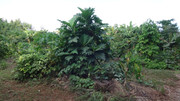I practice some techniques that aren't always common in standard orchards. I interplant under over and around my trees with different plants trying to emulate something more like nature. I plant legumes, vegetables, herbs, flowers and ground covering plants dense enough that they form a community. Every so often I go through and trim these plants so they aren't competing for light, moisture or space. I call these cuttings "chop & drops" because usually the prunings are left in place as a mulch.
About 1-1/2 months ago I did a chop & drop in an area and this week noticed that two trees in particular had just taken a huge stride in growth. They had been poking along all summer and even though we haven't had any change in rain or weather something had really happened. They are nearly 3 year old Rollinia which hasn't really done too well, looked a little yellow and hadn't grown a lot through the season and a 3 year old Breadfruit . Around them was a great growth of a ground covering plant called Longevity spinach(Gynura procumbens). When cut it probably amounted to a wheelbarrow load of fresh green matter that I put aroud each tree.
I've heard some people speak of how pruning adjacent plants sends "information" out into mycelial networks communicating signals for growth and renewal. On the other side, when plants die off or senesce, an opposite signal might occur towards a reduction of growth or a dormancy and pulling back of resources. The reaction of these trees to just the stimulus of pruning around them has really got me thinking.
What do you think?
here is an article explaining some of what science research has found:
https://www.the-scientist.com/features/plant-talk-38209here is the Rollinia, it has flushed better than it ever has, about a foot of growth:

here is the Breadfruit, it did Ok through the summer rainy season, but has suddenly jumped nearly 2 feet:
